The New Motorola Moto X (2nd Gen) Review
by Joshua Ho on September 17, 2014 9:00 AM EST- Posted in
- Smartphones
- Motorola
- Android
- Mobile
Display
Without question, the display is one of the most important aspects of a smartphone. Unlike desktops and laptops, smartphones are primarily interacted with through their displays. Unfortunately, it’s hard to evaluate a display by eye as human vision is strongly dependent upon context. In order to control for this aspect, we turn to SpectraCal’s CalMAN 5 with a custom workflow in order to test smartphone displays. At any rate, let’s get into the data.
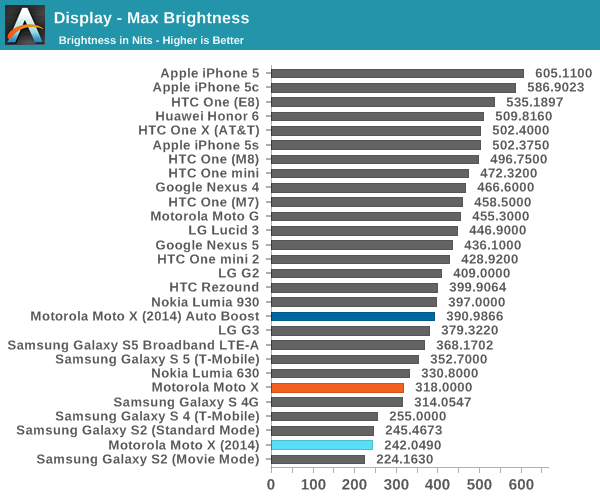
In the basics, the new Moto X is a bit on the low side. While AMOLED has traditionally struggled with luminance in situations such as the web browser and light-themed applications, Samsung’s Galaxy S5 and S5 LTE-A Broadband have shown that it’s possible to achieve levels of brightness approaching some of the brightest RGB-stripe LCDs. As the brightness of the Lumia 930 is about equal to the new Moto X, I suspect we're looking at the Galaxy S4/Note 3 generation of panels. This seems to be backed up by pictures of the subpixel layout seen below as the green subpixels seem to be noticeably larger when compared to the Galaxy S5's panel.
Contrast is still incredible, but I can still see the purple smearing effect that comes from unlit to lit pixels. I’m still unable to get a clear answer on why this is, but it’s likely that capacitance somewhere in the system is causing this issue in the form of RC delay. Whether this is a fixable issue is something I’m not aware of yet. The clear solution would be to set black to the lowest possible brightness a lit pixel can be, but this would make for worse contrast.

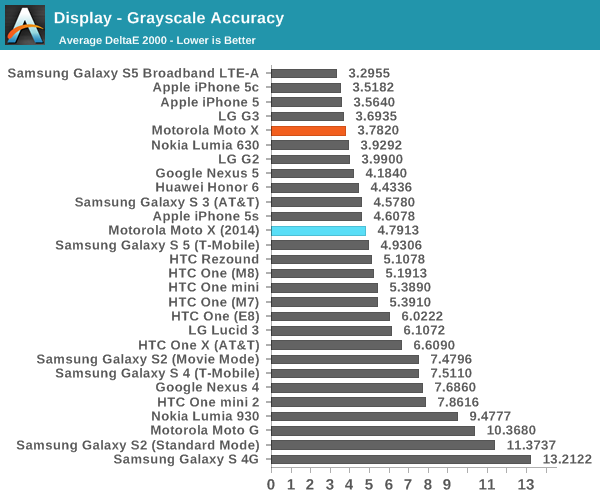
In grayscale, the new Moto X isn’t the best. We see that the display is just a bit too red, and that most of the luminance is coming from red and green. This makes sense from a power and display lifetime perspective though, as blue tends to have the least efficient emitter material in an AMOLED display. However, this translates to poor grayscale performance. The green tint tends to show itself in certain shades of grayscale as well.

In our saturation sweep, the new Moto X continues to be rather poor in its performance. While on Samsung phones it’s normal to see colors like this on the default display mode, there’s usually a mode that correctly constrains the display to sRGB which is the industry standard for displaying colors. There’s no such mode on the new Moto X, so the display significantly overshoots sRGB. This doesn’t bode well for the ColorChecker, which provides the most thorough look at color accuracy.
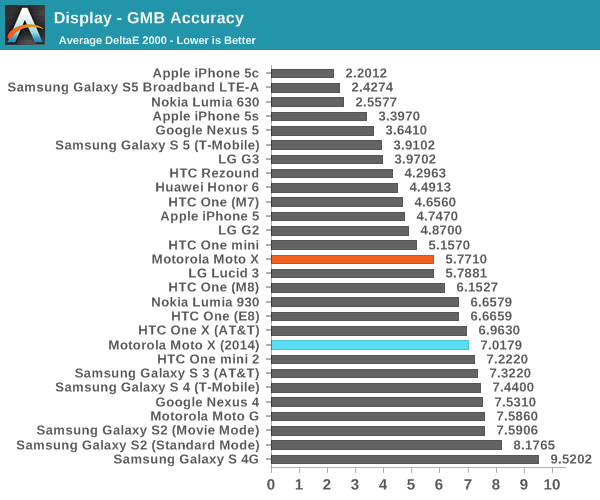
As predicted, the new Moto X does poorly in the ColorChecker. There’s really not much that the Moto X can accurately display in sRGB as just by pushing the gamut too far, even if there wasn’t saturation compression for some colors, the large gamut will cause distortion of all colors within the gamut triangle.
Unfortunately, it’s not clear where this lack of attention to color accuracy comes from. In discussions with Andrei it's clearly possible to calibrate the AMOLED panel from the GS4 quite accurately, and there's no real technical limitation for AMOLED to lack good calibration. However, judging by the relatively low peak brightness there are other issues as this could affect Motorola's performance in battery life tests. This seems to suggest that Motorola is unable to access the latest generation of AMOLED panels from Samsung Display.
This would be a rather startling thought, as it means that no matter what Motorola does to improve their implementation of Samsung’s AMOLED displays, they will always be behind the curve. If it becomes clear that Samsung’s AMOLED is the best display from a user-facing standpoint, every other OEM will face significant barriers in competition as they would be unable to access the latest generation AMOLED panels. The real solution here is for other display manufacturers such as LG, JDI, and AUO Optronics to catch up.
At any rate, the display of the new Moto X seems to be relatively poor compared to what we see in the Galaxy S5 LTE-A (and likely the Note 4), along with the iPhone 5s, Nexus 5, and One (M7). While it’s impossible to ignore the power advantage of AMOLED when implementing functions like Moto Display, the relatively low peak brightness and poor color accuracy are concerning.


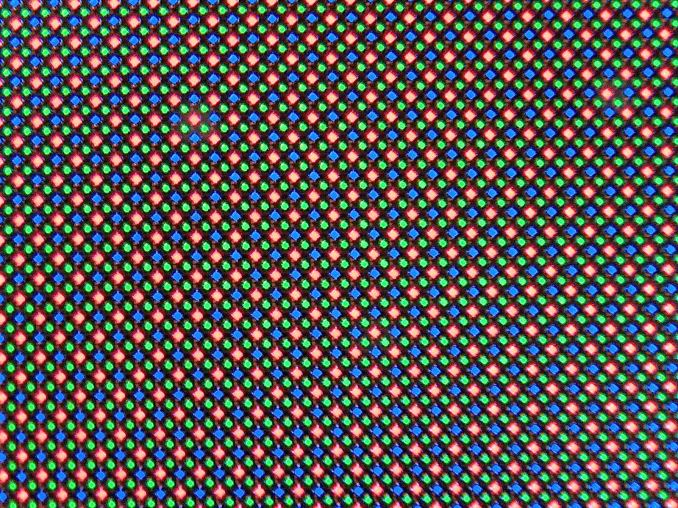

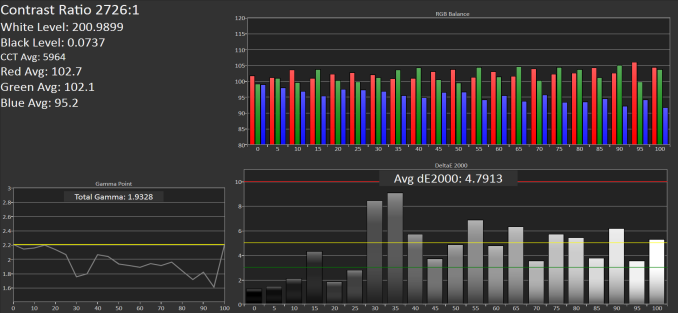

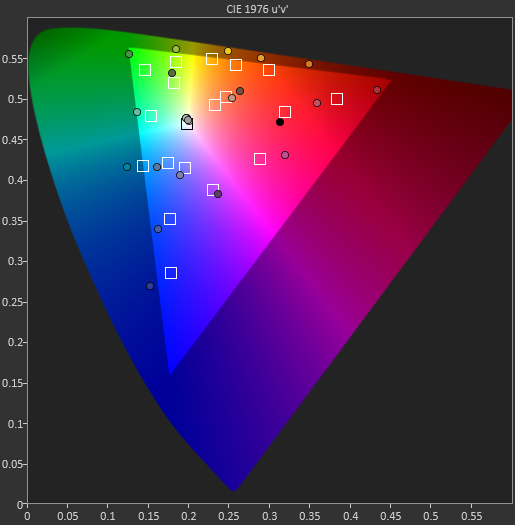








179 Comments
View All Comments
adityarjun - Wednesday, September 17, 2014 - link
He wasn't gloating about it, he was just sharing his happiness. From his tone, it sounds like he respects AT a lot and it was a pleasant surprise for him to be the first one to comment.It is not like, he just wrote "First!!!".
rituraj - Wednesday, September 17, 2014 - link
You sir, have earned my sincere respectbeggerking@yahoo.com - Wednesday, September 17, 2014 - link
lol gratz!Peroxyde - Wednesday, September 17, 2014 - link
Oh no way, me too I have a dream of marrying someone "first" poster in AT article. If you are a guy and is OK to have a sex change operation, then we can talk business later.batongxue - Wednesday, September 17, 2014 - link
Those FCC stuff on the bottom. Yikesadityarjun - Wednesday, September 17, 2014 - link
Yup, that part looks really bad!!Harry_Wild - Wednesday, September 17, 2014 - link
Since many people are not familiar with metric measurements in the U.S.; why not give them in inches? This means nothing to me: 140.8 x 72.4 x 3.8-9.9 mm!JetSter735180 - Wednesday, September 17, 2014 - link
Do you know how stupid your comment sounds ? Just because you don't use the metric system, you can at least take 5 seconds and search the conversion formula or even use google to convert it for you.Their are 196 counties in the world and 193 of them officially use the metric system. Its taught in first grade of most of these countries.
Kristian Vättö - Wednesday, September 17, 2014 - link
And just FYI, even Motorola only lists the measurements in metric on their US site:https://www.motorola.com/us/motomaker?pid=FLEXR2#m...
Fergy - Wednesday, September 17, 2014 - link
I thought the USA officially converted to metric about a hundred years ago. It is just that people are so stubborn that they won't use it.